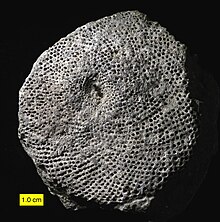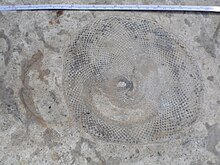| Receptaculites Temporal range: 488–250 Ma PreꞒ Ꞓ O S D C P T J K Pg N | |
|---|---|

| |
| Receptaculitid from the Ordovician of Estonia. | |
| Scientific classification | |
| Clade: | Viridiplantae |
| Division: | Chlorophyta |
| Class: | Ulvophyceae |
| Order: | Dasycladales (?) |
| Family: | †Receptaculitaceae |
| Genus: | †Receptaculites Defrance 1827 |
| Species | |
| |
Receptaculites is the name-bearing genus for an extinct group of conspicuous benthic marine genera, the receptaculitids (formally Receptaculitaceae or Receptaculitidae), that lived from the Early Ordovician through the Permian period, peaking in the Middle Ordovician. The group's phylogenetic origin has long been obscure, with some arguing that they were calcareous algae, probably of the order Dasycladales. Receptaculitids lived in warm, shallow seas, but consensus disagreeing. They have been described from all continents except Antarctica. In some areas they were important reef-formers, and they also occur as isolated specimens.


Receptaculites and its relatives have a double-spiral, radiating pattern of rhombus-shaped plates supported by spindle-like objects called meroms. Fossils can usually be identified by the intersecting patterns of clockwise and counterclockwise rows of plates or stalk spaces, superficially similar to the arrangement of disk florets on a sunflower—hence the common name "sunflower coral" (sic).
Receptaculitids have sometimes been compared to the morphologically similar, but probably distantly related, cyclocrinitids.
References
- ^ Guiry, M.D.; Guiry, G.M. "Receptaculites". AlgaeBase. University of Galway. Retrieved 2022-02-28.
- "Family: Receptaculitidae". The Paleobiology Database. Retrieved 2011-08-15.
- ^ Byrnes, J.G. 1968. Notes on the nature and environmental significance of the Receptaculitaceae. Lethaia, vol. 1, p. 368-381.
- Beadle, S. C. (1991). "Cyclocrinitids". Calcareous Algae and Stromatolites. pp. 114–124. doi:10.1007/978-3-642-52335-9_6. ISBN 978-3-642-52337-3.
- Nitecki, Matthew H.; Webby, Barry D.; Spjeldnaes, Nils; Yong-Yi, Zhen (2004). "31. Receptaculitids and Algae". The Great Ordovician Biodiversification Event. pp. 336–347. doi:10.7312/webb12678-032. ISBN 9780231126786.
- Rietschel, S. and Nitecki, M.H. 1984. Ordovician Receptaculitid algae from Burma. Palaeontology, vol. 27, p. 415-420.
- Pratt, B.R. and Weissenberger, J., 1988. Fore-slope Receptaculitid mounds from the Frasnian of the Rocky Mountains, Alberta. In: Reefs: Canada and adjacent areas, Canadian Society of Petroleum Geologists Memoir 13, p. 510-513.
- Wilson, Mark (2017-02-10). "Wooster's Fossil of the Week: A receptaculitid (Middle Ordovician of Missouri)". Retrieved 2021-05-19.
- Stinchcomb, Bruce L. (November 1997). "Missouri Fossils". Rocks & Minerals. 72 (6): 393–399. doi:10.1080/00357529709605072.
- Nitecki, Matthew H.; Webby, Barry D.; Spjeldnaes, Nils; Yong-Yi, Zhen (31 December 2004). "31. Receptaculitids and Algae". The Great Ordovician Biodiversification Event: 336–347. doi:10.7312/webb12678-032. ISBN 9780231126786.
- Beadle, Steven C. (January 1988). "Dasyclads, cyclocrinitids and receptaculitids: comparative morphology and paleoecology". Lethaia. 21 (1): 1–12. doi:10.1111/j.1502-3931.1988.tb01745.x.

| Taxon identifiers | |
|---|---|
| Receptaculites | |
- Paleozoic plants
- Ulvophyceae genera
- Fossil algae
- Early Ordovician first appearances
- Permian genus extinctions
- Paleozoic life of Ontario
- Paleozoic life of Alberta
- Paleozoic life of British Columbia
- Paleozoic life of Manitoba
- Paleozoic life of Newfoundland and Labrador
- Paleozoic life of the Northwest Territories
- Paleozoic life of Nunavut
- Paleozoic life of Quebec